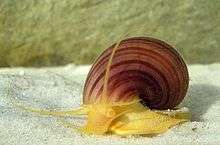Pomacea bridgesii
| Pomacea bridgesii | |
|---|---|
 | |
| Pomacea bridgesii in aquarium | |
| Scientific classification | |
| Kingdom: | Animalia |
| Phylum: | Mollusca |
| Class: | Gastropoda |
| (unranked): | clade Caenogastropoda informal group Architaenioglossa |
| Superfamily: | Ampullarioidea |
| Family: | Ampullariidae |
| Genus: | Pomacea |
| Subgenus: | Pomacea |
| Species: | P. bridgesii |
| Binomial name | |
| Pomacea bridgesii (Reeve, 1856) | |
- See also: Pomacea diffusa, formerly known as Pomacea bridgesii.
Pomacea bridgesii, common names the spike-topped apple snail or mystery snail, is a South American species of freshwater snail with gills and an operculum, an aquatic gastropod mollusk in the family Ampullariidae.
Subspecies
- Pomacea bridgesii bridgesii (Reeve, 1856)
- Pomacea bridgesii diffusa (Blume, 1957)
Anatomy
Apple snails possess structurally complex eyes at the tip of a cephalic eyestalk. These snails possess the ability to regenerate the eye completely after amputation through the mid-eyestalk. They are born with both gills and lungs. Mystery snails also obtain a siphon which is a small tube like feature used to breathe air. They frequently surface to the top of the water to breathe.[2]
Distribution
The native distribution of this snail is Bolivia, Brazil, Paraguay and Peru.
Non-indigenous distribution
This species is non-indigenous in Hawaii since 1960 (Pomacea bridgesii diffusa), southeast Asia since the 1980s, and Florida since the early 1980s (Pomacea bridgesii diffusa).[3]
Offspring
Most apple snails lay their eggs above the water line, and can reproduce asexually. The eggs take 2–4 weeks to hatch. The snails can produce as many as two-hundred offspring from one egg-laying event. Sometimes not all of the eggs are fertilized so they don't all hatch. When they do hatch, the hatchlings run the risk of getting eaten if they share an aquarium with fish.
Human relevance
This species is often kept as an aquarium pet, because of its wide range of shell colors, lack of appetite for live plants, and ease of care. However mystery snails do require proper maintenance although they seem like simple creatures. Many domestic mystery snails or those in pet stores suffer health issues. Regular calcium intake is required for their shells. Many mystery snail owners make food called snail jello for their pets to eat. Nutritious vegetables and as well calcium supplements can be added to this.
References
- ↑ Pastorino, G. & Darrigan, G. (2011). "Pomacea bridgesii". The IUCN Red List of Threatened Species. IUCN. 2011: e.T189088A8678453. doi:10.2305/IUCN.UK.2011-2.RLTS.T189088A8678453.en. Retrieved 15 January 2018.
- ↑ Bover, M. M. (1988). "Eye regeneration in the mystery snail". J. Exp. Zool. 245 (1): 33–42. doi:10.1002/jez.1402450106. PMID 3351443.
- ↑ Pomacea bridgesi at applesnail.net
External links
| Wikimedia Commons has media related to Pomacea_bridgesii. |
